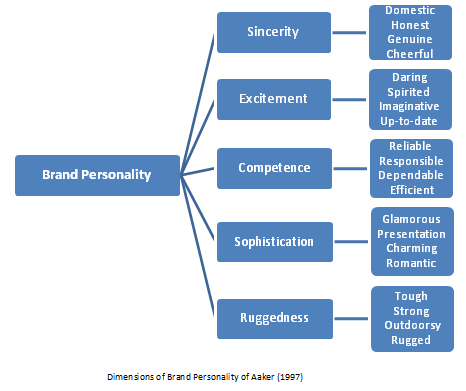What is Brand Image Analysis?
Brand image represents the emotional aspects that identify a brand of a company or its products and has a powerful impact on consumer buying behavior (Arora & Stoner, 2009). Consumers select a product not only for its commodity but also for the image associated with the product and for the identification with other users of the brand (ex. Nike brand image was associated with the famous basketball player Michael Jordan). The definition of brand image is not stable and differs from one author to another. The American Marketing Association (AMA) defines brand as a «name, term, design, symbol, or any other feature that identifies one seller’s good or service as distinct from those of other sellers»; while brand image is defined as a «perception of a brand in the minds of persons […]. It is what people believe about a brand, their thoughts, feelings, expectations» (AMA). Aaker and Kellers, define respectively brand image as a «set of associations, usually organized in some meaningful way » (Aaker, 1992) and a «perceptions about a brand as reflected by the brand associations held in consumer memory» (Keller, 1993).
What about brand personality?
While a brand image represents all the emotional aspects that identify a brand, a brand personality represent human characteristics that have been given to a brand (Aaker, 1997). In other words, a brand personality is an aspect of the brand image (Opoku, 2006). Azoulay and Kapferer (2003) consider that personal values and physical traits are also human characteristics that can be associated with a brand. Therefore, they suggest defining brand personality as «the set of human personality traits that are both applicable to and relevant for brands» (Azoulay & Kapferer, 2003). Similar to Azoulay & Kapferer (2003) definition, Esomar defines brand personality as «an expression of the fundamental core values and characteristics of a brand, described and experienced as human personality traits, eg. friendly, intelligent, innovative, etc. It is an expression of the relationship between the consumer and the brand». In order to measure brand personality, many authors used Aaker’s (1997) scale that identifies five dimensions of human characteristics associated with a brand: Sincerity, Excitement, Competence, Sophistication, and Ruggedness.
How Provalis Research software is used for brand image analysis?
Brand image and personality has been widely studied in marketing. Researchers want to know what consumers think of a specific brand and see if there is a similarity between the brand image the company wants to project, through marketing and the one in the consumer’s mind. While the majority of studies use quantitative methods for studying brand image analysis (Arora & Stoner, 2009; Srnka & Koeszegi, 2007), a growing number of researchers are adopting a qualitative approach. Arora & Stoner (2009) used QDA Miner, our qualitative analysis software, to compare the brand personality of two brand stores (Walmart and Target) and two sports brands of clothes and shoes (Nike and Adidas). The authors used QDA Miner to codify interview responses and identify distinct personality dimensions associated with each brand. Opoku et al. (2011) investigated business schools’ websites in South Africa in order to find what brand personality each school featured. To identify a brand personality, the authors have built and applied a brand personality dictionary with WordStat, our content analysis, and text mining software, to analyze the associations between the content of websites and Aaker’s five brand personality dimensions (Sincerity, Excitement, Competence, Sophistication, and Ruggedness). Adopting a similar approach in a B2B context, Campbell et al (2008) studied brand personality portrayed by some clients and their suppliers, through the content of their websites. The authors wanted to identify whether similarity in brand personality affects the success of a B2B relationship. Papania et al (2008) analyzed the association between Aaker’s brand personality dimensions and the website content of several biotechnology firms. The authors showed that the information communicated by firms on their websites reflects the brand personality they wanted to project, even unintentionally. The authors suggest that managers should use a content analysis methodology in order to ensure that the information they communicate through their website reflects a positive and appropriate image to their stakeholders.
List of studies
Campbell, C., Papania, L., Parent, M., Cyr, D. (2010). An exploratory study into brand alignment in B2B relationships. Industrial Marketing Management, 39(2). 712-720
Eisenman, M. (2007). Aesthetic innovation: changing institutional logics in standardized high-technology industries. Technology, Innovation and Institutions Working Paper Series. Technology Commercialization Centre; University of Alberta
Opoku, R.A. (2006). Towards a methodological design for evaluating online brand positioning. Doctoral dissertation, Department of Business Administration and Social Sciences. Luleå University of Technology.
Opoku, R. Abratt, R. & Pitt, L. (2006). Communicating brand personality: Are the websites doing the talking for the top South African Business Schools? Journal of Brand Management (2006) 14, 20-39.
Opoku, R., Hultman, M., & Salehi-Sangari, E. (2008). Positioning in market space: The evaluation of Swedish universities’ online brand personalities. Journal of Marketing for Higher Education, 18 (1), 124-144.
Papania, L., Campbell, C., Opoku, R. Styven, M., & Berthon, J.P. (2008). Using brand personality to assess whether biotechnology firms are saying the right things to their network. Journal of Commercial Biotechnology, 14 (3), 247-25
Pitt, L.F. & Papania,L. (2007). In the words: managerial approaches to exploring corporate intended image through content analysis. Journal of General Management, 32(4), 1-16
Powell, S. & Dodd, C. (2007). Managing vision and the brand within the creative industries. Corporate Communications: An International Journal, 12(4), 394-413.
Selected References
Aaker, Jennifer (1997), “Dimensions of Brand Personality”, Journal of Marketing Research, 34, 347-356.
Keller, K.L. (1993), “Conceptualizing, Measuring, and Managing Customer-Based Brand Equity”, Journal of Marketing, 57, 1-22.
If you have published or unpublished articles, presentation papers, or a web page that documents how you used WordStat and if you would like to have this document added to this page, please contact us



